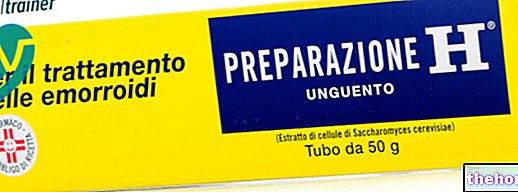Active ingredients: Magnesium hydroxide
MAGNESIA S.PELLEGRINO 45% effervescent powder
The package leaflets of Magnesia san pellegrino are available for the packs:- MAGNESIA S.PELLEGRINO 45% effervescent powder
- MAGNESIA S. PELLEGRINO 90% powder for oral suspension
- MAGNESIA S. PELLEGRINO 900 mg effervescent powder
Why is Magnesia San Pellegrino used? What is it for?
What is it
Magnesium hydroxide, the active ingredient in MAGNESIA S.PELLEGRINO, acts as an antacid against heartburn when taken in low doses. At higher doses, it has a "laxative action (see" How to use this medicine ").
Why is it used
Magnesia S. Pellegrino is used for the short-term treatment of occasional constipation. Antacid.
Contraindications When Magnesia san Pellegrino should not be used
Hypersensitivity (allergy) to the active substance or to any of the excipients.
Laxatives are contraindicated in subjects with acute abdominal pain or of unknown origin, nausea or vomiting, intestinal obstruction or stenosis, rectal bleeding of unknown origin, severe dehydration. Generally contraindicated during pregnancy and in pediatric age.
Contraindicated in case of severe renal insufficiency.
Precautions for use What you need to know before taking Magnesia san pellegrino
The treatment of chronic or recurrent constipation always requires the intervention of the physician for the diagnosis, the prescription of the drugs and the surveillance during the therapy.
Consult your doctor when the need for the laxative derives from a sudden change in previous bowel habits (frequency and characteristics of bowel movements) lasting more than two weeks or when the use of the laxative fails to produce effects.
It is also advisable for elderly people or those in poor health to consult their doctor before using the medicine.
When it can only be used after consulting your doctor In case of:
- stubborn constipation
- kidney disease (prescription only)
- diabetes or low-calorie diets (see "It is important to know that")
- intolerance to sugars (see "It is important to know that")
- low-sodium diets (see "It is important to know that")
- pregnancy (see "What to do during pregnancy and breastfeeding")
- children under 12 years It is advisable to consult your doctor even in cases where these disorders have occurred in the past.
Interactions Which drugs or foods can modify the effect of Magnesia san Pellegrino
Tell your doctor or pharmacist if you have recently taken any other medicines, even those without a prescription.
Laxatives can reduce the time spent in the intestine, and therefore the absorption, of other drugs administered simultaneously orally.
Therefore, avoid taking laxatives and other drugs at the same time: after taking a medicine, leave an interval of at least 2 hours before taking the laxative.
The product must not be taken simultaneously with antibiotics of the tetracycline class, indomethacin-based drugs, phosphorus, dexamethasone, digitalis, iron salts, nitrofurantoin, lincomycin as it reduces their absorption and consequently their activity. Use of the medicinal product may reduce the rate of quinidine excretion, with the risk of overdose.
Milk or antacids can change the effect of the medicine; allow an interval of at least one hour to elapse before taking the laxative.
It is advisable not to administer other drugs by mouth within 1 or 2 hours of taking the product.
Warnings It is important to know that:
The abuse of laxatives (frequent or prolonged use or with excessive doses) can cause persistent diarrhea with consequent loss of water, mineral salts (especially potassium) and other essential nutritional factors.
In severe cases, the onset of dehydration or hypokalaemia (decrease in potassium in the blood) is possible, which can cause cardiac or neuromuscular dysfunctions, especially in the case of simultaneous treatment with cardiac glycosides, diuretics or corticosteroids.
The abuse of laxatives, especially contact laxatives (stimulant laxatives), can cause addiction (and, therefore, the possible need to gradually increase the dosage), chronic constipation and loss of normal intestinal functions (intestinal atony).
What to do during pregnancy and breastfeeding
The medicine should only be used when needed, under the direct supervision of the doctor, after evaluating the expected benefit to the mother in relation to the possible risk to the fetus. Consult your doctor if you suspect pregnancy or wish to plan a maternity leave.
Magnesium is considered compatible with breastfeeding, ask your doctor or pharmacist before taking the medicine.
Effects on ability to drive and use machines
Magnesia S. Pellegrino does not affect the ability to drive or use machines.
It is important to know that:
If you have noticed a sudden and persistent change in your bowel habits for more than two weeks, contact your doctor before using a laxative.
Laxatives should not be used for longer than one week. The continuous use of laxatives can cause habit in their use or damage of a different kind. If there is persistent constipation, consult your doctor.
In case of rectal bleeding or lack of bowel movements after administration of the laxative it is necessary to consult your doctor.
Important information about some of the excipients
MAGNESIA S. PELLEGRINO contains sucrose: this should be taken into account in case of low-calorie diets (low in calories) or diabetes. If you have a sugar intolerance, consult your doctor before taking the medicine. In case of low-salt diets (low in salts), it should be borne in mind that the product contains sodium salts.
Health education notes
First of all it must be borne in mind that, in most cases, a balanced diet rich in water and fiber (bran, vegetables and fruit) can permanently solve the problem of constipation.
Many people think they suffer from constipation if they fail to evacuate every day. This is a mistaken belief as this situation is completely normal for a large number of individuals.
Consider, instead, that constipation occurs when the bowel movements are reduced compared to your personal habits and are associated with the emission of hard stools. If the episodes of constipation occur repeatedly, the doctor must be consulted.
Dosage and method of use How to use Magnesia San Pellegrino: Dosage
To open the 100 g bottle: break the protective seal, match the tip of the arrow on the cap with that on the bottle and pull.
How many
- ADULTS:
- as an antacid: 1 teaspoon;
- as a laxative: 1 teaspoon;
- as a purgative: 1 tbsp.
- CHILDREN aged between 6 and 12: half the doses
Warning: do not exceed the indicated doses.
As a laxative the correct dose is the minimum sufficient to produce an easy evacuation of soft faeces. It is advisable to initially use the minimum doses provided. When necessary, the dose can then be increased, but without ever exceeding the maximum indicated.
When and for how long
Take preferably in the evening.
Laxatives should be used as infrequently as possible and for no more than seven days.
The use for longer periods of time requires a doctor's prescription after adequate evaluation of the individual case.
Consult your doctor if the disorder occurs repeatedly or if you notice any recent change in its characteristics.
Warning: use only for short periods of treatment.
Like
Dissolve the powder in half a glass of water. Swallow with an adequate quantity of water (a large glass). A diet rich in liquids favors the effect of the medicine.
Overdose What to do if you have taken an overdose of Magnesia san Pellegrino
Excessive doses can cause abdominal pain and diarrhea; consequent losses of fluids and electrolytes must be replaced. See also the information in the paragraph "Precautions for use - Warnings" about the abuse of laxatives.
In case of accidental ingestion / intake of an excessive dose of MAGNESIA S. PELLEGRINO, notify your doctor immediately or contact the nearest hospital.
If you have any questions about the use of Magnesia S. Pellegrino, ask your doctor or pharmacist.
Side Effects What are the side effects of Magnesia san pellegrino
Like all medicines, Magnesia S. Pellegrino can cause side effects, although not everybody gets them.
Occasionally: diarrhea, isolated cramping pains or abdominal colic, more frequent in cases of severe constipation.
Compliance with the instructions contained in the package leaflet reduces the risk of undesirable effects. If any of the side effects gets serious or if you notice any side effects not listed in this leaflet, please inform your doctor or pharmacist.
Expiry and Retention
Expiry: see the expiry date indicated on the package. The expiry date refers to the product in intact packaging, correctly stored.
Warning: do not use the medicine after the expiry date indicated on the package.
Medicines should not be disposed of via wastewater or household waste. Ask your pharmacist how to dispose of medicines you no longer use. This will help protect the environment.
Keep this medicine out of the reach and sight of children.
It is important to always have the information about the medicine available, so keep both the box and the package leaflet.
Deadline "> Other information
Composition
100 g of effervescent powder contain:
- Active ingredient: magnesium hydroxide 45 g
- Excipients:
- without flavor: sucrose, tartaric acid, sodium bicarbonate
- anise flavor: sucrose, tartaric acid, sodium bicarbonate, anethole
- lemon flavor: sucrose, tartaric acid, sodium bicarbonate, natural lemon flavor
- mandarin flavor: sucrose, tartaric acid, sodium bicarbonate, natural mandarin flavoring
- fruit flavor: sucrose, tartaric acid, sodium bicarbonate, natural fruit flavor
How it looks
The contents of a pack of MAGNESIA S. PELLEGRINO is:
- without flavor: box of 15 g, bottle of 100 g or 125 g
- anise flavor: bottle of 100 g or 125 g
- lemon flavor: 15 g box, 90 g, 100 g or 125 g bottle
- mandarin flavor: box of 15 g, bottle of 90 g, 100 g or 125 g
- fruit flavor: 90 g or 100 g bottle
Source Package Leaflet: AIFA (Italian Medicines Agency). Content published in January 2016. The information present may not be up-to-date.
To have access to the most up-to-date version, it is advisable to access the AIFA (Italian Medicines Agency) website. Disclaimer and useful information.
01.0 NAME OF THE MEDICINAL PRODUCT -
MAGNESIA S.PELLEGRINO
02.0 QUALITATIVE AND QUANTITATIVE COMPOSITION -
100 g of powder contain:
Magnesia S. Pellegrino 90% powder for oral suspension
Active ingredient: magnesium hydroxide 90 g
Excipients: sucrose.
Magnesia S. Pellegrino 45% effervescent powder
Active ingredient: magnesium hydroxide 45 g
Excipients: sucrose.
For the full list of excipients, see section 6.1.
03.0 PHARMACEUTICAL FORM -
Powder for oral suspension. Effervescent powder.
04.0 CLINICAL INFORMATION -
04.1 Therapeutic indications -
Short-term treatment of occasional constipation. Antacid.
04.2 Posology and method of administration -
Adults: as an antacid 1 teaspoon of coffee; as a laxative 1 teaspoon; as a purgative 1 tbsp.
Children: between 6 and 12 years: half the doses.
Dilute the powder in half a glass of water and ingest.
The correct dose is the minimum sufficient to produce easy evacuation of soft stools. It is advisable to initially use the minimum doses provided. When necessary, the dose can then be increased, but without ever exceeding the maximum indicated.
Take preferably in the evening.
Laxatives should be used as infrequently as possible and for no more than seven days. The use for longer periods of time requires a doctor's prescription after adequate evaluation of the individual case.
Swallow with an adequate quantity of water (a large glass). A diet rich in liquids favors the effect of the medicine.
Administration of the medicinal product to children under the age of 6 years is not recommended (see section 4.4).
For the use of the medicinal product in elderly patients, in patients in poor health or in patients with kidney disease, see section 4.4.
04.3 Contraindications -
Hypersensitivity to the active substance or to any of the excipients.
Laxatives are contraindicated in subjects with acute abdominal pain or of unknown origin, nausea or vomiting, intestinal obstruction or stenosis, rectal bleeding of unknown origin, severe dehydration.
Generally contraindicated during pregnancy (see section 4.6). Generally contraindicated in pediatric age (see section 4.4).
Severe renal insufficiency (creatinine clearance less than 30 mL / min)
04.4 Special warnings and appropriate precautions for use -
Warnings
The abuse of laxatives (frequent or prolonged use or with excessive doses) can cause persistent diarrhea with consequent loss of water, mineral salts (especially potassium) and other essential nutritional factors.
In severe cases, the onset of dehydration or hypokalemia is possible, which can cause cardiac or neuromuscular dysfunction, especially in the case of simultaneous treatment with cardiac glycosides, diuretics or corticosteroids.
The abuse of laxatives, especially contact laxatives (stimulant laxatives), can cause addiction (and, therefore, the possible need to gradually increase the dosage), chronic constipation and loss of normal intestinal functions (intestinal atony).
Precautions for use
In children under the age of 12, the medicine can only be used after consulting your doctor.
The treatment of chronic or recurrent constipation always requires the intervention of the physician for the diagnosis, the prescription of the drugs and the surveillance during the therapy.
Consult your doctor when the need for the laxative derives from a sudden change in previous bowel habits (frequency and characteristics of bowel movements) lasting more than two weeks or when the use of the laxative fails to produce effects.
It is also advisable for elderly people or those in poor health to consult their doctor before using the medicine.
To be used only on medical prescription in case of kidney disease.
In case of diabetes or low-calorie diets, it should be borne in mind that the product contains sucrose.
Patients with rare hereditary problems of fructose intolerance, glucose-galactose malabsorption or sucrase-isomaltase deficiency should not take the medicine.
For the effervescent powder: in the case of low-sodium diets, it must be borne in mind that the product contains sodium salts.
04.5 Interactions with other medicinal products and other forms of interaction -
Laxatives can reduce the time spent in the intestine, and therefore the absorption, of other drugs administered simultaneously orally.
Therefore, avoid taking laxatives and other drugs at the same time: after taking a medicine, leave an interval of at least 2 hours before taking the laxative.
Magnesium hydroxide, like all antacids, should not be taken at the same time as antibiotics of the tetracycline class as it reduces their absorption.
Milk or antacids can change the effect of the medicine; allow an interval of at least one hour to elapse before taking the laxative.
Association to avoid:
- tetracyclines: formation of insoluble complexes with a reduction in the absorption and activity of these antibiotics.
Association not recommended:
- quinidine: increased plasma rates of quinidine and risk of overdose due to decreased excretion.
Associations requiring precautions for use:
- indomethacin, phosphorus, dexamethasone, digitalis, iron salts, nitrofurantoin, lincomycin: decreased absorption in the digestive system.
04.6 Pregnancy and breastfeeding -
The medicine should only be used when needed, under the direct supervision of the doctor, after evaluating the expected benefit to the mother in relation to the possible risk to the fetus.
Magnesium is considered compatible with breastfeeding.
04.7 Effects on ability to drive and use machines -
Magnesia S. Pellegrino does not affect the ability to drive or use machines.
04.8 Undesirable effects -
Occasionally: diarrhea, isolated cramping pains or abdominal colic, more frequent in cases of severe constipation.
04.9 Overdose -
Excessive doses can cause abdominal pain and diarrhea; consequent losses of fluids and electrolytes must be replaced. See also the information in the section "Special warnings and precautions for use" regarding the abuse of laxatives.
Treatment of magnesium overdose: rehydration, forced diuresis. In case of renal insufficiency, hemodialysis or peritoneal dialysis is required.
05.0 PHARMACOLOGICAL PROPERTIES -
05.1 "Pharmacodynamic properties -
Pharmacotherapeutic group: Antacids, magnesium; ATC code: A02AA04.
Active ingredient of Magnesia S. Pellegrino is magnesium hydroxide, a substance normally present in nature and with a high antacid power and laxative activity.
The activity of Magnesia S. Pellegrino is, according to the quantities taken, antacid, laxative, purgative.
The antacid activity is expressed in the stomach where, in suitable doses, the magnesium hydroxide neutralizes the gastric acid production.
At higher doses, magnesium hydroxide acts in the intestine as an osmotic laxative, promoting evacuation and reducing intestinal bloating if present.
05.2 "Pharmacokinetic properties -
Absorption
Administered orally, magnesium hydroxide performs antacid activity by reacting fairly quickly in the stomach with hydrochloric acid to form magnesium chloride and water.
About one third of the magnesium is absorbed in the intestine.
Elimination
Excretion occurs mainly via the urine.
05.3 Preclinical safety data -
The active ingredient, magnesium hydroxide, is characterized by high tolerability and very low toxicity. Studies on laboratory animals have not shown negative actions by the drug on fertility, nor teratogenic effects.
06.0 PHARMACEUTICAL INFORMATION -
06.1 Excipients -
Magnesia S. Pellegrino powder 90% for oral suspension:
without flavor: sucrose.
lemon flavor: sucrose, natural lemon flavor.
Magnesia S. Pellegrino 45% effervescent powder:
without flavor: sodium bicarbonate, tartaric acid, sucrose.
anise flavor: sodium bicarbonate, tartaric acid, sucrose, anethole.
fruit flavor: sodium bicarbonate, tartaric acid, sucrose, natural fruit flavor.
lemon flavor: sodium bicarbonate, tartaric acid, sucrose, natural lemon flavor.
mandarin flavor: sodium bicarbonate, tartaric acid, sucrose, natural mandarin flavoring.
06.2 Incompatibility "-
Not relevant.
06.3 Period of validity "-
5 years.
06.4 Special precautions for storage -
This medicine does not require any special storage conditions.
06.5 Nature of the immediate packaging and contents of the package -
Magnesia S. Pellegrino 90% powder for oral suspension
without aroma: bottle of 100 g.
lemon flavor: bottle of 100 g.
Magnesia S. Pellegrino 45% effervescent powder
without flavor 15 g box; bottle of 100 g; bottle of 125 g.
anise flavor bottle of 100 g; bottle of 125 g.
fruit flavor: 90 g bottle; bottle of 100 g.
lemon flavor 15 g box; 90 g bottle; bottle of 100 g; bottle of 125 g.
mandarin flavor: box of 15 g; 90 g bottle; bottle of 100 g; bottle of 125 g.
06.6 Instructions for use and handling -
To open the 100 g bottle: break the protective seal, make the tip of the arrow on the cap coincide with that on the bottle and pull.
07.0 HOLDER OF THE "MARKETING AUTHORIZATION" -
Sanofi-aventis S.p.A.
Viale L. Bodio 37 / B - IT-20158 Milan (Italy)
08.0 MARKETING AUTHORIZATION NUMBER -
Magnesia S. Pellegrino 90% powder for oral suspension
without aroma, 100 g bottle AIC 006570028
lemon flavor, 100 g bottle AIC 006570131
Magnesia S. Pellegrino 45% effervescent powder
without aroma 15 g box AIC 006570067
bottle of 100 g AIC 006570232
bottle of 125 g AIC 006570081
anise flavor 100 g bottle AIC 006570244
bottle of 125 g AIC 006570055
fruit flavor 90 g bottle AIC 006570220
bottle of 100 g AIC 006570269
lemon flavor 15 g box AIC 006570093
90 g bottle AIC 006570206
bottle of 100 g AIC 006570257
bottle of 125 g AIC 006570117
mandarin flavor 15 g box AIC 006570143
90 g bottle AIC 006570218
bottle of 100 g AIC 006570271
bottle of 125 g AIC 006570168
09.0 DATE OF FIRST AUTHORIZATION OR RENEWAL OF THE AUTHORIZATION -
Date of first authorization:
Magnesia S. Pellegrino 90% powder for oral suspension: May 26, 1972
Magnesia S. Pellegrino 45% effervescent powder:
without aroma: 15 g box and 125 g bottle 14 October 1977
bottle of 100 g December 17, 1998
anise flavor 125 g bottle 14 October 1977
bottle of 100 g December 17, 1998
fruit flavor bottle 90 g April 20, 1988
bottle of 100 g December 17, 1998
lemon flavor 15 g box and 125 g bottle 14 October 1977
90 g bottle April 20, 1988
bottle of 100 g December 17, 1998
mandarin flavor: 15 g box and 125 g bottle 14 October 1977
90 g bottle April 20, 1988
bottle of 100 g December 17, 1998
Last renewal date 30 May 2005.
10.0 DATE OF REVISION OF THE TEXT -
November 2009.




























